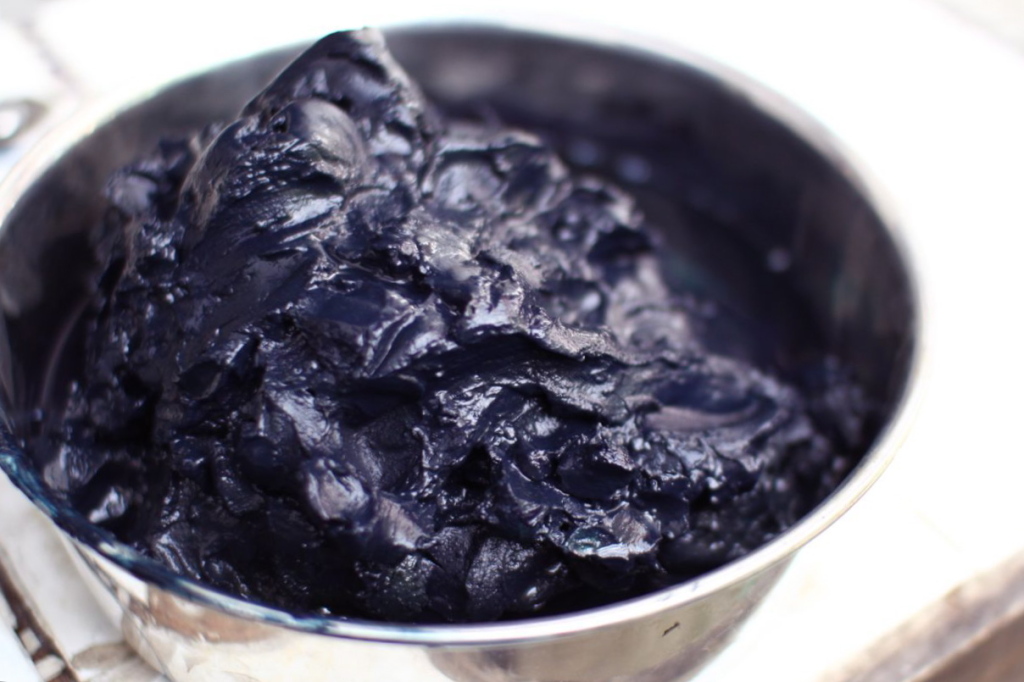Using only materials provided by Nature to make dye produced by “natural-ash fermentation.”
In Nagano, I prepare vats of natural indigo by fermenting indigo leaves with live bacteria. I use sukumo (composted indigo leaves from Tokushima, Japan) and Ryukyu ai (indigo extract from Okinawa).
Of course, it is easier to use chemicals (such as commercially available caustic soda) as reducing agents, but I use only natural materials as reducing agents, (plant or tree ash, natural sugars, . . .) in natural-ash fermentation.
The advantages of this method are twofold: the resulting indigo colour lasts much longer than that produced through non-fermenting methods, and the process is not harmful to the environment.
■Preparing a vat of naturally fermented indigo


28kg of fermented indigo leaf (sukumo) from Tokushima, Japan
200L of lye made from apple-tree ash and well water
I combine the above two ingredients in a ceramic pot, and mix them well together. I cover the vat to keep the liquid indigo warm and to encourage fermentation.

The indigo liquid in the vat is ready for dyeing, when a coppery film develops on its surface.

■How to dye
I submerge each pre-moistened garment in the liquid by hand, then gently move it around in the vat for 10-30 minutes. I remove the garment and wash it by hand three times under running well water.
I hang each garment in the open air in shade and wait 15 minutes while the oxygen in the air oxidizes the dye. This process is repeated 10 to 20 times to produce the darkest shades of blue.
To achieve truly dark indigo shades can take a month or more, because the bacteria in the vats “tires” quickly and must be given time to replenish itself. As a result, the number of garments one can dye within a day is limited, another important difference between using only natural indigo dye versus chemical dyes.

The indigo-dyed garments are then soaked in well water and rinsed thoroughly several times to eliminate any unwanted brown discoloration from latent lye.
■Kinds of indigo
-Composted indigo leaves from Tokushima, Japan, (sukumo) is dried and composted Polygonaceae leaves.
Making sukumo is labor intensive, and there are few specialists remaining who know how to produce indigo compost, in Tokushima, Japan.
It takes almost one year to make sukumo. Indigo plants are seeded in the spring, and the mature plants are harvested in summer. The leaves are separated from stems, finely ground, dried well, and mounded into large piles indoors. Water is sprinkled occasionally on the pile of indigo leaves, which is turned over many times, as the mass ferments for 100 days.
Indigo extract from Okinawa

–Indigo extract from Okinawa
Indigo extract paste (Ryukyu ai ) is made from Strobilanthes cusia in Okinawa. The dye pigment is extracted from a fermented pool of fresh leaves and water.
To make 20kg of this indigo extract paste, one needs 200kg of fresh indigo leaves.

■ Natural indigo vs chemical indigo
Most so-called “indigo-dyed” garments, such as blue jeans, are dyed chemically with synthetic indigo.
Even if it is claimed that a garment has been dyed with “natural indigo,” sodium hydrosulphite is almost always used as a reducing agent in commercial indigo dyeing processes. This chemical compound is harmful to the environment and can contaminate groundwater.
Also, the color fastnesses of indigo-color dyes using sodium hydrosulphite as a reducing agent is not so long compared with that which results from indigo dye produced naturally in an ash-fermentation vat.
© 2020 atelier indochine All text and photos on this website are protected by copyright. It is unlawful to copy or otherwise use them without the express permission of the author or photographer.